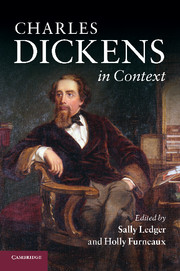Book contents
- Frontmatter
- Contents
- List of illustrations
- Notes on contributors
- Preface
- Notes on references
- PART I LIFE AND AFTERLIFE
- 1 The life of Dickens 1: before Ellen Ternan
- 2 The life of Dickens 2: after Ellen Ternan
- 3 Dickens's lives
- 4 Victorian stage adaptations and novel appropriations
- 5 Reviewing Dickens in the Victorian periodical press
- 6 The European context
- 7 Major twentieth-century critical responses
- 8 Modern stage adaptations
- 9 Modern screen adaptations
- 10 The heritage industry
- 11 Neo-Victorian Dickens
- PART II SOCIAL AND CULTURAL CONTEXTS
- Further reading
- Index
9 - Modern screen adaptations
Published online by Cambridge University Press: 05 August 2012
- Frontmatter
- Contents
- List of illustrations
- Notes on contributors
- Preface
- Notes on references
- PART I LIFE AND AFTERLIFE
- 1 The life of Dickens 1: before Ellen Ternan
- 2 The life of Dickens 2: after Ellen Ternan
- 3 Dickens's lives
- 4 Victorian stage adaptations and novel appropriations
- 5 Reviewing Dickens in the Victorian periodical press
- 6 The European context
- 7 Major twentieth-century critical responses
- 8 Modern stage adaptations
- 9 Modern screen adaptations
- 10 The heritage industry
- 11 Neo-Victorian Dickens
- PART II SOCIAL AND CULTURAL CONTEXTS
- Further reading
- Index
Summary
Ever since the cinema came into existence, Dickens's works have been continually adapted to the screen. This is, no doubt, partly due to Dickens's popularity and partly due to the close affinity between his novels and this art form: the plastically visible characters, melodrama, montage, orchestration of sensuous details, which were brilliantly observed by the Russian director Eisenstein. As the films are numerous, I must be highly selective in my discussion, in which I adopt Linda Hutcheon's view that ‘an adaptation is a derivation that is not derivative – a work that is second without being secondary’. A film adaptation should be judged on its own terms, rather than on whether it is ‘faithful’ to Dickens (whatever that may mean).
The first Dickens film was, as far as we can ascertain, The Death of Nancy Sykes (1897). It is unfortunately lost, and the oldest of the preserved films is Scrooge; Or, Marley's Ghost (1901). The most famous, and perhaps most interesting, adaptation of the silent period is Oliver Twist (1922). It features Lon Chaney and the child star Jackie Coogan, who in the previous year had brilliant success in Chaplin's The Kid. This film manages to pack in much of the novel in about an hour, and in several places it anticipates David Lean's version (see below): the Punch and Judy show in the background of the ‘Stop, thief!’ sequence; the subjective shot when Oliver loses consciousness at Fang's court; the use (if clumsy) of Bull's Eye at Sikes's murder of Nancy; the shot of the tightened rope suggesting Sikes's death by hanging.
- Type
- Chapter
- Information
- Charles Dickens in Context , pp. 67 - 73Publisher: Cambridge University PressPrint publication year: 2011
- 1
- Cited by

